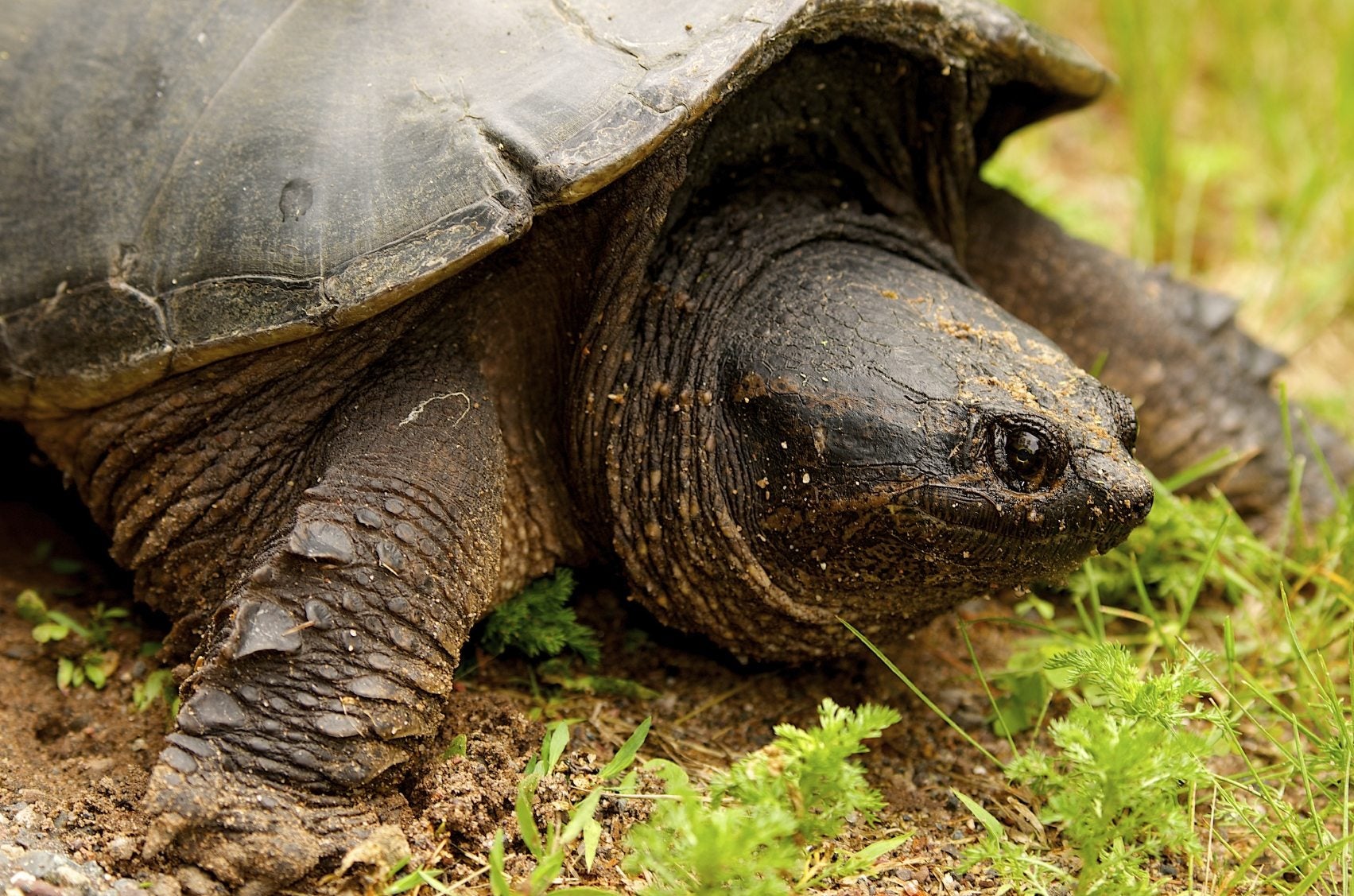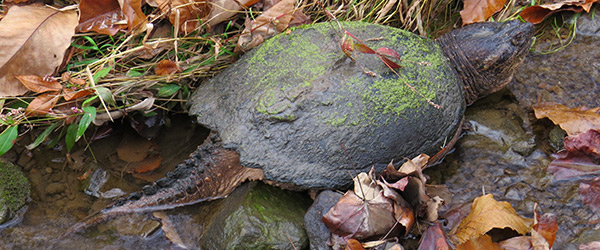To get rid of a snapping turtle, contact a wildlife professional for safe removal. Avoid handling it yourself.
Encountering a snapping turtle on your property can be concerning, as these creatures can be dangerous. It’s essential to handle the situation cautiously to ensure both your safety and the turtle’s well-being. In this guide, we will explore effective methods for removing a snapping turtle from your premises without causing harm to the animal.
By following these steps, you can safely and humanely address the presence of a snapping turtle on your property. Let’s delve into the best practices for dealing with these reptiles and ensuring a peaceful coexistence.
Identifying The Threat
Recognizing A Snapping Turtle
Snapping turtles have a large head, sharp beak-like jaws, and a long tail.
They can reach up to 20 inches in shell length and have rough, ridged shells.
Understanding The Risks
Snapping turtles are known to be aggressive when provoked or threatened.
They can deliver powerful bites that may cause injury or infection.

Credit: www.instagram.com
Safety Precautions
When dealing with snapping turtles, it is crucial to prioritize safety for both yourself and the turtle. By taking the necessary precautions, you can minimize the risk of injury and ensure a successful removal process.
Protective Gear
Proper protective gear is essential when handling snapping turtles. Wear thick gloves to shield your hands from potential bites and scratches. Additionally, protective eyewear can safeguard your eyes from any unexpected movements or debris.
Handling Techniques
When approaching a snapping turtle, it’s important to exercise caution and utilize appropriate handling techniques. Avoid sudden movements that could startle the turtle, and approach from the rear to minimize the risk of being bitten. When lifting the turtle, support its body securely to prevent it from thrashing or escaping.
Legal Considerations
When dealing with a snapping turtle problem, it’s crucial to be aware of the legal considerations. Depending on your location, there may be specific regulations and guidelines in place for handling and removing these protected species. It’s essential to research and understand the laws before taking any action.
Legal considerations are crucial when dealing with snapping turtles. Local regulations, permits, and permissions must be understood and adhered to before attempting to remove or relocate a snapping turtle.Local Regulations
It is essential to be aware of the local laws and regulations regarding the handling and removal of snapping turtles. Contact your local wildlife agency to inquire about specific regulations in your area.Permits And Permissions
In some regions, a permit may be required to handle or relocate snapping turtles due to their protected status. Consult with the appropriate authorities to obtain the necessary permits and permissions before taking any action. Understanding the legal considerations surrounding snapping turtles is vital to ensure compliance with regulations and to protect the well-being of these creatures.Non-lethal Removal Methods
To safely remove a snapping turtle, opt for non-lethal methods like relocation to a distant water body. Use caution and protective gear to handle them without causing harm. Seek professional assistance for safe and humane removal practices.
Dealing with a snapping turtle can be a challenging task. These creatures are known for their aggressive behavior and sharp jaws. However, there are non-lethal removal methods that you can use to get rid of them. In this article, we will discuss two effective methods of non-lethal removal: trapping and relocation, and natural deterrents.Trapping And Relocation
Trapping and relocation is one of the most effective methods of removing snapping turtles. Here’s how you can do it:- Get a humane trap that is designed for capturing turtles. These traps are available at most hardware stores.
- Bait the trap with something that turtles like, such as fish or meat.
- Place the trap near the water where you have seen the turtle.
- Check the trap regularly, and once you have captured the turtle, relocate it to a suitable location. Make sure that the new location is far away from residential areas and water sources.
Natural Deterrents
If you want to keep snapping turtles away from your property, there are some natural deterrents that you can use. Here are a few:- Install a fence around your property. Make sure that the fence is at least two feet high and extends below the ground.
- Place chicken wire or mesh around your pond or water source to prevent turtles from entering.
- Remove any food sources that might attract turtles, such as fish or other aquatic animals.
- Use noise deterrents, such as wind chimes or ultrasonic devices, to keep turtles away from your property.
- Plant prickly plants around your pond or water source. Turtles will avoid areas with thorny or prickly plants.
Professional Assistance
Snapping turtles are known for their aggressive nature, sharp beak-like mouth, and strong jaws that can cause serious injury. If you have a snapping turtle problem in your yard or pond, it’s important to take action to protect yourself and your family. While there are several methods you can use to get rid of a snapping turtle, seeking professional assistance is the safest and most effective option.
Wildlife Control Services
Wildlife control services are experts in dealing with a variety of wildlife problems, including snapping turtles. They have the knowledge, experience, and equipment necessary to safely and humanely remove snapping turtles from your property. Wildlife control services will also ensure that the turtles are relocated to a safe and suitable habitat where they can continue to thrive.
Expert Consultation
If you’re not sure what to do about your snapping turtle problem, consider consulting with an expert. Many wildlife control services offer consultations where they can assess your situation, provide advice, and recommend the best course of action. A consultation with an expert can also help you understand the legal requirements for removing snapping turtles in your area.
Conclusion
Getting rid of a snapping turtle can be a challenging and potentially dangerous task. Seeking professional assistance is the safest and most effective option. Wildlife control services and expert consultation are two great options to consider. Remember to always prioritize your safety and the well-being of the snapping turtles.
Creating An Unwelcoming Environment
To create an unwelcoming environment for a snapping turtle, remove any sources of food or shelter. Installing a fence or barrier can also deter them from entering your property. Seek professional help for safe and humane removal if needed.
Creating an Unwelcoming Environment for snapping turtles is essential for keeping them away from your property. By modifying their habitat and avoiding food sources, you can effectively discourage them from staying in your area.Modifying Habitat
To deter snapping turtles from your property, make sure to keep the environment less appealing to them. This can be achieved by removing any potential nesting sites, such as piles of leaves or brush, and filling in any holes or burrows where they might seek shelter. Additionally, installing barriers like fences or mesh can prevent them from accessing your property.Avoiding Food Sources
Snapping turtles are attracted to food sources such as fish, frogs, and small mammals. To discourage them from staying in your area, it’s important to avoid leaving out pet food, birdseed, or any other potential meals for them. Keeping your property free of potential food sources will make it less enticing for snapping turtles to stick around. By creating an unwelcoming environment through modifying their habitat and avoiding food sources, you can effectively deter snapping turtles from your property.Educational Outreach
When dealing with the presence of snapping turtles in our environment, educational outreach plays a crucial role in fostering understanding and collaboration within the community. By raising awareness and providing informational resources, we can empower individuals to take responsible and effective action in managing snapping turtle populations.
Community Awareness Programs
Community awareness programs are essential in educating the public about the behavior and ecological significance of snapping turtles. Through interactive workshops, presentations, and outreach events, local organizations can engage community members of all ages in learning about the importance of coexisting with these unique reptiles. By fostering a sense of stewardship and respect for the natural world, these programs can inspire individuals to become advocates for the protection of snapping turtles and their habitats.
Informational Resources
Providing access to informational resources is key in equipping individuals with the knowledge they need to address snapping turtle encounters effectively. Online guides, brochures, and fact sheets can offer practical tips on safely interacting with snapping turtles and implementing conservation practices. By making these resources readily available, we can empower people to make informed decisions that benefit both snapping turtles and the local environment.

Credit: www.gardeningknowhow.com
Conservation And Coexistence
Conservation and Coexistence: In our efforts to manage snapping turtle populations, it is crucial to prioritize conservation and coexistence with these unique creatures. By understanding their behavior and implementing strategies for peaceful cohabitation, we can protect these turtles while maintaining a harmonious environment.
Respecting Wildlife Habitats
Snapping turtles play a vital role in their ecosystems, so it is essential to respect their natural habitats. Avoid disrupting their nesting areas and refrain from removing them from their environment.
Promoting Harmony
- Promote harmony by educating others about snapping turtles and their importance.
- Implement measures to reduce human-turtle conflicts, such as securing trash cans.
- Encourage responsible pet ownership to prevent negative interactions with turtles.

Credit: www.turtleskingston.com
Conclusion
If you encounter a snapping turtle, stay calm and keep a safe distance. Contact local wildlife authorities for assistance in relocating the turtle. Remember, respect for wildlife is key in coexisting harmoniously. By following these tips, you can safely handle encounters with snapping turtles while preserving their natural habitat.






Leave a Reply